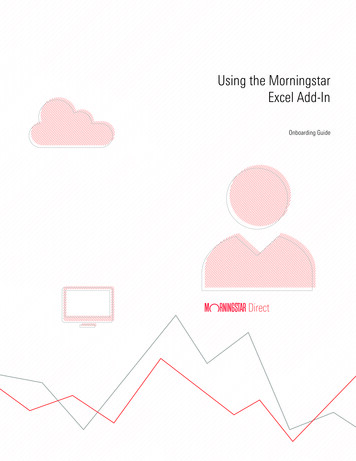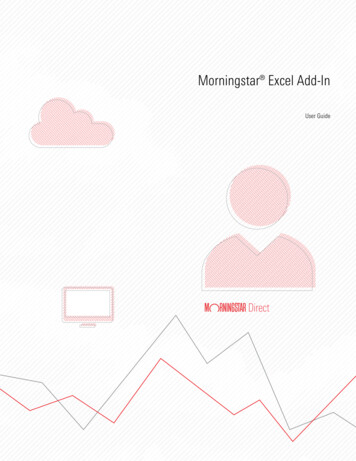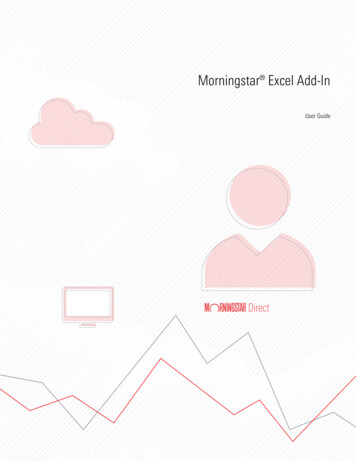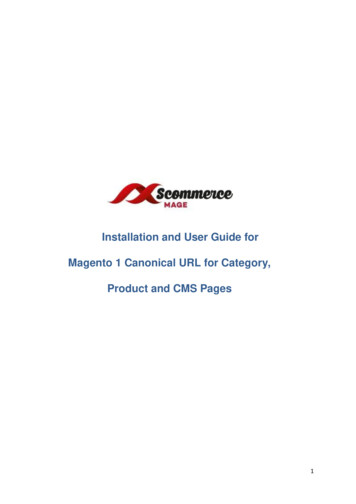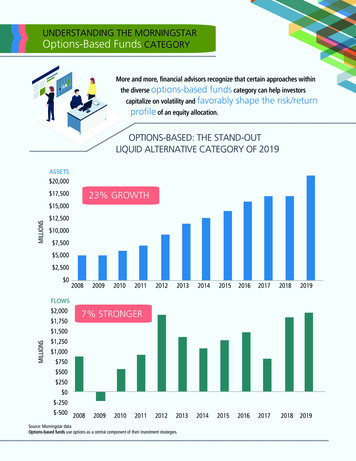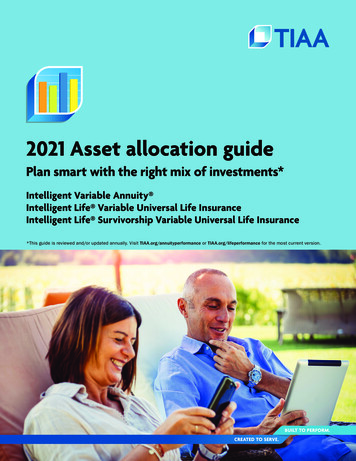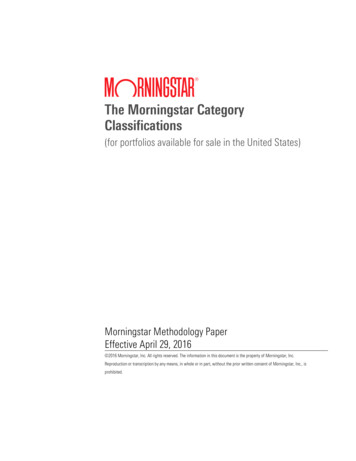
Transcription
The Morningstar CategoryClassifications(for portfolios available for sale in the United States)Morningstar Methodology PaperEffective April 29, 2016 2016 Morningstar, Inc. All rights reserved. The information in this document is the property of Morningstar, Inc.Reproduction or transcription by any means, in whole or in part, without the prior written consent of Morningstar, Inc., isprohibited.
ContentsCategory List3Introduction7Category Review Process8Changes9U.S. Equity12Sector Equity16Allocation20International Equity27Alternative32Commodities38Taxable Bond40Municipal Bond46Money Market51The Morningstar Category Classifications April 29, 2016 2016 Morningstar, Inc. All rights reserved. The information in this document is the property of Morningstar, Inc. Reproduction or transcription by any means,in whole or part, without the prior written consent of Morningstar, Inc., is prohibited.2
Category ListCategory GroupU.S. EquityCategory NameLarge Value12U.S. EquityU.S. EquityU.S. EquityU.S. EquityU.S. EquityU.S. EquityU.S. EquityU.S. EquityU.S. EquityLarge BlendLarge GrowthMid-Cap ValueMid-Cap BlendMid-Cap GrowthSmall ValueSmall BlendSmall GrowthLeveraged Net Long121213131314141415Sector EquitySector EquitySector EquitySector EquitySector EquitySector EquitySector EquitySector EquitySector EquitySector EquitySector EquitySector EquitySector EquitySector EquitySector EquitySector EquityCommunicationsConsumer CyclicalConsumer DefensiveEnergy Limited PartnershipEquity EnergyEquity Precious MetalsFinancialGlobal Real EstateHealthIndustrialsInfrastructureNatural ResourcesReal EstateTechnologyUtilitiesMiscellaneous location--15% to 30% EquityAllocation--30% to 50% EquityAllocation--50% to 70% EquityAllocation--70% to 85% EquityAllocation--85% EquityConvertiblesWorld AllocationTactical AllocationTarget-Date 2000-2010Target-Date 2015Target-Date 20202020202021212122222223The Morningstar Category Classifications April 29, 2016 2016 Morningstar, Inc. All rights reserved. The information in this document is the property of Morningstar, Inc. Reproduction or transcription by any means,in whole or part, without the prior written consent of Morningstar, Inc., is prohibited.3
Category List (continued)Category ory NameTarget-Date 2025Target-Date 2030Target-Date 2035Target-Date 2040Target-Date 2045Target-Date 2050Target-Date 2055Target-Date 2060 Target-Date Retirement232324242425252526International EquityInternational EquityInternational EquityInternational EquityInternational EquityInternational EquityInternational EquityInternational EquityInternational EquityInternational EquityInternational EquityInternational EquityInternational EquityInternational EquityInternational EquityInternational EquityForeign Large-ValueForeign Large-BlendForeign Large-GrowthForeign Small/Mid-ValueForeign Small/Mid-BlendForeign Small/Mid-GrowthWorld StockDiversified Emerging MarketsDiversified Pacific/AsiaMiscellaneous RegionEurope StockLatin America StockPacific/Asia ex-Japan StockChina RegionIndia EquityJapan ar rnativeAlternativeMulticurrencySingle CurrencyLong-Short CreditLong-Short EquityMarket NeutralMultialternativeManaged FuturesOption WritingVolatilityTrading--Leveraged Commodities32323333333434343535The Morningstar Category Classifications April 29, 2016 2016 Morningstar, Inc. All rights reserved. The information in this document is the property of Morningstar, Inc. Reproduction or transcription by any means,in whole or part, without the prior written consent of Morningstar, Inc., is prohibited.4
Category List (continued)Category lternativeAlternativeCategory NameTrading--Inverse CommoditiesTrading--Leveraged DebtTrading--Inverse DebtTrading--Leveraged EquityTrading--Inverse sCommodities oditiesCommoditiesCommodities Broad BasketCommodities EnergyCommodities Industrial MetalsCommodities MiscellaneousCommodities Precious Metals3838383939Taxable BondTaxable BondTaxable BondTaxable BondTaxable BondTaxable BondTaxable BondTaxable BondTaxable BondTaxable BondTaxable BondTaxable BondTaxable BondTaxable BondTaxable BondTaxable BondTaxable BondTaxable BondLong GovernmentIntermediate GovernmentShort GovernmentInflation-Protected BondLong-Term BondIntermediate-Term BondShort-Term BondUltrashort BondBank LoanStable ValueCorporate BondPreferred StockHigh-Yield BondMultisector BondWorld BondEmerging-Markets BondEmerging-Markets Local-Currency BondNontraditional Bond404041414142424243434343444444444545The Morningstar Category Classifications April 29, 2016 2016 Morningstar, Inc. All rights reserved. The information in this document is the property of Morningstar, Inc. Reproduction or transcription by any means,in whole or part, without the prior written consent of Morningstar, Inc., is prohibited.5
Category List (continued)Category GroupMunicipal BondMunicipal BondMunicipal BondMunicipal BondMunicipal BondMunicipal BondMunicipal BondMunicipal BondMunicipal BondMunicipal BondMunicipal BondMunicipal BondMunicipal BondMunicipal BondMunicipal BondMunicipal BondCategory NameMuni National LongMuni National IntermediateMuni National ShortHigh-Yield MuniMuni Single State LongMuni Single State IntermediateMuni Single State ShortMuni California LongMuni California IntermediateMuni MassachusettsMuni MinnesotaMuni New JerseyMuni New York LongMuni New York IntermediateMuni OhioMuni Pennsylvania46464647474747484848484949494950Money MarketMoney MarketMoney MarketTaxable Money MarketTax-Free Money MarketPrime Money Market515151The Morningstar Category Classifications April 29, 2016 2016 Morningstar, Inc. All rights reserved. The information in this document is the property of Morningstar, Inc. Reproduction or transcription by any means,in whole or part, without the prior written consent of Morningstar, Inc., is prohibited.6
IntroductionThe Morningstar Category classifications were introduced in 1996 to help investors makemeaningful comparisons between mutual funds. Morningstar found that the investmentobjective listed in a fund’s prospectus often did not adequately explain how the fund actuallyinvested. For example, many funds claimed to be seeking “growth,” but some of those wereinvesting in established blue-chip companies while others were investing in small-capcompanies.The Morningstar Category classifications solved this problem by breaking portfoliosinto peer groups based on their holdings. The categories help investors identify the topperforming funds, assess potential risk, and build well-diversified portfolios. Morningstarregularly reviews the category structure and the portfolios within each category to ensure thatthe system meets the needs of investors.Morningstar assigns categories to all types of portfolios, such as mutual funds,variable annuities, and separate accounts. Portfolios are placed in a given category based ontheir average holdings statistics over the past three years. Morningstar’s editorial team alsoreviews and approves all category assignments. If the portfolio is new and has no history,Morningstar estimates where it will fall before giving it a more permanent categoryassignment. When necessary, Morningstar may change a category assignment based on recentchanges to the portfolio.The driving principles behind the classification system are as follows: Individual portfolios within a category invest in similar types of securities andtherefore share the same risk factors (for example, style risk, prepayment risk). Individual portfolios within a category can, in general, be expected to behave moresimilarly to one another than to portfolios outside the category. The aggregate performance of different categories differs materially over time. Categories have enough constituents to form the basis for reasonable peer groupcomparisons. The distinctions between categories are meaningful to investors and assist in theirpursuit of investing goals.In the United States, Morningstar supports 122 categories, which map into nine categorygroups (U.S. equity, sector equity, allocation, international equity, alternative, commodities,taxable bond, municipal bond, and money market). The category group indexes and categoryindexes listed with each category are used in Morningstar’s tools and reports to showperformance relative to a benchmark.The Morningstar Category Classifications April 29, 2016 2016 Morningstar, Inc. All rights reserved. The information in this document is the property of Morningstar, Inc. Reproduction or transcription by any means,in whole or part, without the prior written consent of Morningstar, Inc., is prohibited.7
Category Review ProcessMorningstar engages in a formal category review process twice each year, in May andNovember; additional reviews for funds less than one year old are also conducted in Februaryand August.The process begins with a quantitative filter that proposes category recommendations basedupon the three-year trailing portfolio statistics, which are calculated from an investment’sreported holdings. There is a wealth of data used in this process, but the statistics examinedcoincide with the major portfolio components we use to define categories, such as assetallocation, market capitalization, value-growth score, and duration. The recommendations forchanges to existing category assignment are then reviewed by the Manager Research analystswho accept or reject the system’s proposals. Our research team uses a mosaic approach whenperforming our qualitative assignment. Their decision is based on many factors, including, butnot limited to: familiarity with the strategy of the portfolio managers and fund family, theirunderstanding of current market forces, an appreciation for alternative strategies which maynot be borne out adequately in our statistical calculations, and a desire to portray the mostaccurate picture of economic exposure possible.After we propose a change to a fund’s category, we notify fund representatives for eachinvestment. Category changes are sent to the fund’s advisor with ample time to challenge ouropinion, and provide contravening information in a category appeal. Once an appeal is receivedthe change is escalated and reviewed again by a second group of analysts.In addition to the formal review processes, we accept category appeals throughout the year.Morningstar reviews all appeals, but generally rejects those that are based only upon aphilosophical difference in the category definition. Successful appeals typically provideinformation demonstrating that our analysis is incomplete or inaccurate. These off-quarterreviews are reserved for mis-categorizations that are due to incorrect initial assignment for newfunds, data errors, strategy changes, or missing or incomplete data. Regardless of when theserequests are received, all category changes are made on the last business day of the month inwhich they are reviewed. Changes to the category assignment as a result of this process aretypically available in products by the third business day of the month following the reviewperiod. Appeals can be submitted only by fund representatives, and not by third-parties. In thecase that a category change was initiated by a Morningstar analyst, we will notify fundrepresentatives and offer an appeal period.Fund representatives may request an appeal form by emailing category@morningstar.com.The Morningstar Category Classifications April 29, 2016 2016 Morningstar, Inc. All rights reserved. The information in this document is the property of Morningstar, Inc. Reproduction or transcription by any means,in whole or part, without the prior written consent of Morningstar, Inc., is prohibited.8
ChangesApril 29, 2016 Added Infrastructure; Emerging-Markets Local-Currency Bond; Target-Date 2060 ; OptionWriting; Long-Short Credit; Prime Money Market; Allocation—15% to 30% Equity;Allocation—85% Equity Renamed: Target Date 2051 to Target-Date 2055; Conservative Allocation to Allocation—30% to 50% Equity; Moderate Allocation to Allocation—50% to70% Equity; AggressiveAllocation to Allocation—70% to 85% Equity; Added Morningstar Index assignments to categories Added Category Review Process sectionApril 30, 2014 Added Energy Limited PartnershipOctober 31, 2013 Added Corporate Bond, Preferred Stock and Tactical AllocationApril 30, 2013 Re-named Currency to Multicurrency Added Single Currency Added Miscellaneous Region Re-named U.S. Broad Asset Class to U.S. Category Group and Global Broad Asset Class toGlobal Broad Category Group Renamed U.S. Category Groups (Balanced to Allocation, US Stock to US Equity,International Stock to International Equity, and Sector Stock to Sector Equity)April 30, 2012 Created the Sector Stock U.S. Broad Asset Class, and moved 14 categories from U.S. Stock,International Stock, and Alternative asset classes into this new asset class Re-launched Muni Single State Short Replaced Target-Date 2050 with Target-Date 2051 Added India Equity, Foreign Small/Mid-Blend, Target-Date 2046-2050 Re-named Muni-Short to Muni National ShortOctober 31, 2011 Added Nontraditional Bond Replaced Consumer Staples with Consumer Defensive and Consumer Discretionary withConsumer CyclicalThe Morningstar Category Classifications April 29, 2016 2016 Morningstar, Inc. All rights reserved. The information in this document is the property of Morningstar, Inc. Reproduction or transcription by any means,in whole or part, without the prior written consent of Morningstar, Inc., is prohibited.9
Changes (continued)April 30, 2011 Replaced Long/Short with Long/Short Equity Added Multialternative, Volatility, Trading--Leveraged Commodities, Trading--InverseCommodities, Trading--Leveraged Debt, Trading--Inverse Debt, Trading--Leveraged Equity,Trading--Inverse Equity, Trading—MiscellaneousSept. 30, 2010 Added Aggressive Allocation and China Region, and made the Market Neutral categoryavailable to all universes Removed Muni Single State ShortJune 30, 2009 Added the Commodities broad asset class and six commodities categories: Broad Basket,Energy, Precious Metals, Agriculture, Industrial Metals, and Miscellaneous Added Consumer Discretionary, Consumer Staples, Equity Energy, and IndustrialsJan. 30, 2009 Introduced Target-Date categories in five-year increments for years 2011-2050 Added Retirement Income Added Miscellaneous SectorJuly 31, 2008 Added Global Real Estate and Currency Added the Alternative broad asset class Removed Muni FloridaSept. 30, 2007 Added Leveraged Net Long and Market Neutral to the separate accounts and customfunds databasesFeb. 28, 2006 Added Inflation-Protected Bond, Long-Short, Target-Date 2000-2014, Target-Date 20152029, and Target-Date 2030 Added the Balanced broad asset classThe Morningstar Category Classifications April 29, 2016 2016 Morningstar, Inc. All rights reserved. The information in this document is the property of Morningstar, Inc. Reproduction or transcription by any means,in whole or part, without the prior written consent of Morningstar, Inc., is prohibited.10
Changes (continued)May 31, 2004 Replaced the Muni Single State Intermediate/Short category with two new categories:Muni Single State Intermediate and Muni Single State Short Added Stable Value category (currently used for custom funds and separate accounts only)Sept. 30, 2003 Replaced the Foreign Stock category with five new categories: Foreign Large Value,Foreign Large Blend, Foreign Large Growth, Foreign Small/Mid-Value, and ForeignSmall/Mid-GrowthMarch 30, 2003 Discontinued Domestic Hybrid and split into Conservative Allocation and ModerateAllocation Created Bear Market, Bank Loan, High Yield Muni, Muni Florida, Muni Pennsylvania, MuniMassachusetts, Muni New Jersey, Muni Ohio, and Muni Minnesota Name changes: International Hybrid to World Allocation, International Bond to World BondThe Morningstar Category Classifications April 29, 2016 2016 Morningstar, Inc. All rights reserved. The information in this document is the property of Morningstar, Inc. Reproduction or transcription by any means,in whole or part, without the prior written consent of Morningstar, Inc., is prohibited.11
U.S. EquityLarge ValueLarge-value portfolios invest primarily in big U.S. companies that are less expensive or growingmore slowly than other large-cap stocks. Stocks in the top 70% of the capitalization of the U.S.equity market are defined as large cap. Value is defined based on low valuations (low priceratios and high dividend yields) and slow growth (low growth rates for earnings, sales, bookvalue, and cash flow).Category Group Index: S&P 500 TRCategory Index: Russell 1000 Value TR USDMorningstar Index: Morningstar US Large Val TR USDLarge BlendLarge-blend portfolios are fairly representative of the overall US stock market in size, growthrates and price. Stocks in the top 70% of the capitalization of the US equity market are definedas large cap. The blend style is assigned to portfolios where neither growth nor valuecharacteristics predominate. These portfolios tend to invest across the spectrum of USindustries, and owing to their broad exposure, the portfolios' returns are often similar to thoseof the S&P 500 Index.Category Group Index: S&P 500 TRCategory Index: Russell 1000 TR USDMorningstar Index: Morningstar US Large Cap TR USDLarge GrowthLarge-growth portfolios invest primarily in big U.S. companies that are projected to grow fasterthan other large-cap stocks. Stocks in the top 70% of the capitalization of the U.S. equitymarket are defined as large cap. Growth is defined based on fast growth (high growth rates forearnings, sales, book value, and cash flow) and high valuations (high price ratios and lowdividend yields). Most of these portfolios focus on companies in rapidly expanding industries.Category Group Index: S&P 500 TRCategory Index: Russell 1000 Growth TR USDMorningstar Index: Morningstar US Large Growth TR USDThe Morningstar Category Classifications April 29, 2016 2016 Morningstar, Inc. All rights reserved. The information in this document is the property of Morningstar, Inc. Reproduction or transcription by any means,in whole or part, without the prior written consent of Morningstar, Inc., is prohibited.12
U.S. Equity (continued)Mid-Cap ValueSome mid-cap value portfolios focus on medium-size companies while others land herebecause they own a mix of small-, mid-, and large-cap stocks. All look for U.S. stocks that areless expensive or growing more slowly than the market. The U.S. mid-cap range for marketcapitalization typically falls between 1 billion and 8 billion and represents 20% of the totalcapitalization of the U.S. equity market. Value is defined based on low valuations (low priceratios and high dividend yields) and slow growth (low growth rates for earnings, sales, bookvalue, and cash flow).Category Group Index: S&P 500 TRCategory Index: Russell Midcap Value TR USDMorningstar Index: Morningstar US Mid Val TR USDMid-Cap BlendThe typical mid-cap blend portfolio invests in U.S. stocks of various sizes and styles, giving it amiddle-of-the-road profile. Most shy away from high-priced growth stocks but aren't so priceconscious that they land in value territory. The U.S. mid-cap range for market capitalizationtypically falls between 1 billion and 8 billion and represents 20% of the total capitalization ofthe U.S. equity market. The blend style is assigned to portfolios where neither growth nor valuecharacteristics predominate.Category Group Index: S&P 500 TRCategory Index: Russell Midcap TR USDMorningstar Index: Morningstar US Mid Cap TR USDMid-Cap GrowthSome mid-cap growth portfolios invest in stocks of all sizes, thus leading to a mid-cap profile,but others focus on midsize companies. Mid-cap growth portfolios target U.S. firms that areprojected to grow faster than other mid-cap stocks, therefore commanding relatively higherprices. The U.S. mid-cap range for market capitalization typically falls between 1 billion and 8billion and represents 20% of the total capitalization of the U.S. equity market. Growth isdefined based on fast growth (high growth rates for earnings, sales, book value, and cash flow)and high valuations (high price ratios and low dividend yields).Category Group Index: S&P 500 TRCategory Index: Russell Mid Cap Growth TR USDMorningstar Index: Morningstar US Mid Core TR USDThe Morningstar Category Classifications April 29, 2016 2016 Morningstar, Inc. All rights reserved. The information in this document is the property of Morningstar, Inc. Reproduction or transcription by any means,in whole or part, without the prior written consent of Morningstar, Inc., is prohibited.13
U.S. Equity (continued)Small ValueSmall-value portfolios invest in small U.S. companies with valuations and growth rates belowother small-cap peers. Stocks in the bottom 10% of the capitalization of the U.S. equity marketare defined as small cap. Value is defined based on low valuations (low price ratios and highdividend yields) and slow growth (low growth rates for earnings, sales, book value, and cashflow).Category Group Index: S&P 500 TRCategory Index: Russell 2000 Value TR USDMorningstar Index: Morningstar US Small Val TR USDSmall BlendSmall-blend portfolios favor U.S. firms at the smaller end of the market-capitalization range.Some aim to own an array of value and growth stocks while others employ a discipline thatleads to holdings with valuations and growth rates close to the small-cap averages. Stocks inthe bottom 10% of the capitalization of the U.S. equity market are defined as small cap. Theblend style is assigned to portfolios where neither growth nor value characteristicspredominate.Category Group Index: S&P 500 TRCategory Index: Russell 2000 TR USDMorningstar Index: Morningstar US Small Cap TR USDSmall GrowthSmall-growth portfolios focus on faster-growing companies whose shares are at the lower endof the market-capitalization range. These portfolios tend to favor companies in up-and-comingindustries or young firms in their early growth stages. Because these businesses are fastgrowing and often richly valued, their stocks tend to be volatile. Stocks in the bottom 10% ofthe capitalization of the U.S. equity market are defined as small cap. Growth is defined basedon fast growth (high growth rates for earnings, sales, book value, and cash flow) and highvaluations (high price ratios and low dividend yields).Category Group Index: S&P 500 TRCategory Index: Russell 2000 Growth TR USDMorningstar Index: Morningstar US Small Growth TR USDThe Morningstar Category Classifications April 29, 2016 2016 Morningstar, Inc. All rights reserved. The information in this document is the property of Morningstar, Inc. Reproduction or transcription by any means,in whole or part, without the prior written consent of Morningstar, Inc., is prohibited.14
U.S. Equity (continued)Leveraged Net LongLeveraged net long portfolios seek income by establishing long and short positions in securities.The most common strategy for leveraged net long portfolios is to take long positions insecurities that have been identified as attractive and short positions in securities that havebeen identified as overvalued. These portfolios typically hold long positions in securities with anaggregate value of up to 130% of its net assets. In addition, these portfolios will establish shortpositions in securities with a market value of up to 30% of its net assets. The net long exposuretherefore remains 100%, but it is a leveraged exposure. This category is only used inMorningstar’s custom fund and separate account databases.Category Group Index: S&P 500 TRCategory Index: Russell 3000 TR USDMorningstar Index: Morningstar US Market TR USDThe Morningstar Category Classifications April 29, 2016 2016 Morningstar, Inc. All rights reserved. The information in this document is the property of Morningstar, Inc. Reproduction or transcription by any means,in whole or part, without the prior written consent of Morningstar, Inc., is prohibited.15
Sector EquityCommunicationsCommunications portfolios concentrate on telecommunications and media companies ofvarious kinds. Most buy some combination of cable television, wireless-communications, andcommunications-equipment firms as well as traditional phone companies. A few favorentertainment firms, mainly broadcasters, film studios, publishers, and online service providers.Category Group Index: MSCI ACWI NR USDCategory Index: S&P 1500 Telecom Services TRMorningstar Index: Morningstar US Commun Svc TR USDConsumer CyclicalConsumer cyclical portfolios seek capital appreciation by investing in equity securities of U.S. ornon-U.S. companies in the consumer cyclical sector.Category Group Index: MSCI ACWI NR USDCategory Index: S&P 1500 Cons Discretionary TRMorningstar Index: Morningstar US Consumr Cyclcl TR USDConsumer DefensiveConsumer defensive portfolios seek capital appreciation by investing in equity securities of U.S.or non-U.S. companies that are engaged in the manufacturing, sales, or distribution ofconsumer staples.Category Group Index: MSCI ACWI NR USDCategory Index: S&P 1500 Cons Staples TRMorningstar Index: Morningstar US Consumr Dfnsve TR USDEnergy Limited PartnershipEnergy Limited Partnership funds invest a significant amount of their portfolio in energy masterlimited partnerships. These include but are not limited to limited partnerships specializing inmidstream operations in the energy industry.Category Group Index: MSCI ACWI NR USDCategory Index: Morningstar MLP Composite TR USDMorningstar Index: Morningstar MLP Composite TR USDThe Morningstar Category Classifications April 29, 2016 2016 Morningstar, Inc. All rights reserved. The information in this document is the property of Morningstar, Inc. Reproduction or transcription by any means,in whole or part, without the prior written consent of Morningstar, Inc., is prohibited.16
Sector Equity (continued)Equity EnergyEquity energy portfolios invest primarily in equity securities of U.S. or non-U.S. companies whoconduct business primarily in energy-related industries. This includes and is not limited tocompanies in alternative energy, coal, exploration, oil and gas services, pipelines, natural gasservices, and refineries.Category Group Index: MSCI ACWI NR USDCategory Index: S&P 1500 Energy TRMorningstar Index: Morningstar US Energy TR USDEquity Precious MetalsPrecious-metals portfolios focus on mining stocks, though some do own small amounts of goldbullion. Most portfolios concentrate on gold-mining stocks, but some have significant exposureto silver-, platinum-, and base-metal-mining stocks as well. Precious-metals companies aretypically based in North America, Australia, or South Africa.Category Group Index: MSCI ACWI NR USDCategory Index: MSCI World/Metals & Mining NR USDMorningstar Index: NoneFinancialFinancial portfolios seek capital appreciation by investing primarily in equity securities of U.S.or non-U.S. financial-services companies, including banks, brokerage firms, insurancecompanies, and consumer credit providers.Category Group Index: MSCI ACWI NR USDCategory Index: S&P 1500 Financials TRMorningstar Index: Morningstar US Financial Services TR USDGlobal Real EstateGlobal real estate portfolios invest primarily in non-U.S. real estate securities but may alsoinvest in U.S. real estate securities. Securities that these portfolios purchase include: debtsecurities, equity securities, convertible securities, and securities issued by real estateinvestment trusts and REIT-like entities. Portfolios in this category also invest in real estateoperating companies.Category Group Index: MSCI ACWI NR USDCategory Index: S&P Global REIT TR USDMorningstar Index: Morningstar US Real Estate PR USDThe Morningstar Category Classifications April 29, 2016 2016 Morningstar, Inc. All rights reserved. The information in this document is the property of Morningstar, Inc. Reproduction or transcription by any means,in whole or part, without the prior written consent of Morningstar, Inc., is prohibited.17
Sector Equity (continued)HealthHealth portfolios focus on the medical and health-care industries. Most invest in a range ofcompanies, buying everything from pharmaceutical and medical-device makers to HMOs,hospitals, and nursing homes. A few portfolios concentrate on just one industry segment, suchas service providers or biotechnology firms.Category Group Index: MSCI ACWI NR USDCategory Index: S&P 1500 Health Care TRMorningstar Index: Morningstar US Healthcare TR USDIndustrialsIndustrial portfolios seek capital appreciation by investing in equity securities of U.S. or nonU.S. companies that are engaged in services related to cyclical industries. This includes and isnot limited to companies in aerospace and defense, automotive, chemicals, construction,environmental services, machinery, paper, and transportation.Category Group Index: MSCI ACWI NR USDCategory Index: S&P 1500 Industrials TRMorningstar Index: Morningstar US Industrials TR USDInfrastructureInfrastructure equity funds invest more than 60% of their assets in stocks of companiesengaged in infrastructure activities. Industries considered to be part of the infrastructure sectorinclude: oil & gas midstream; waste management; airports; integrated shipping; railroads;shipping & ports; trucking; engineering & construction; infrastructure operations; and theutilities sector.Category Group Index: MSCI ACWI NR USDCategory Index: DJ
Sector Equity Financial 17 Sector Equity Global Real Estate 17 Sector Equity Health 18 Sector Equity Industrials 18 Sector Equity Infrastructure 18 . Taxable Bond Emerging-Markets Local-Currency Bond 45 Taxable Bond Nontraditional Bond 45 . The Morningstar Category Classifications April 29, 2016
